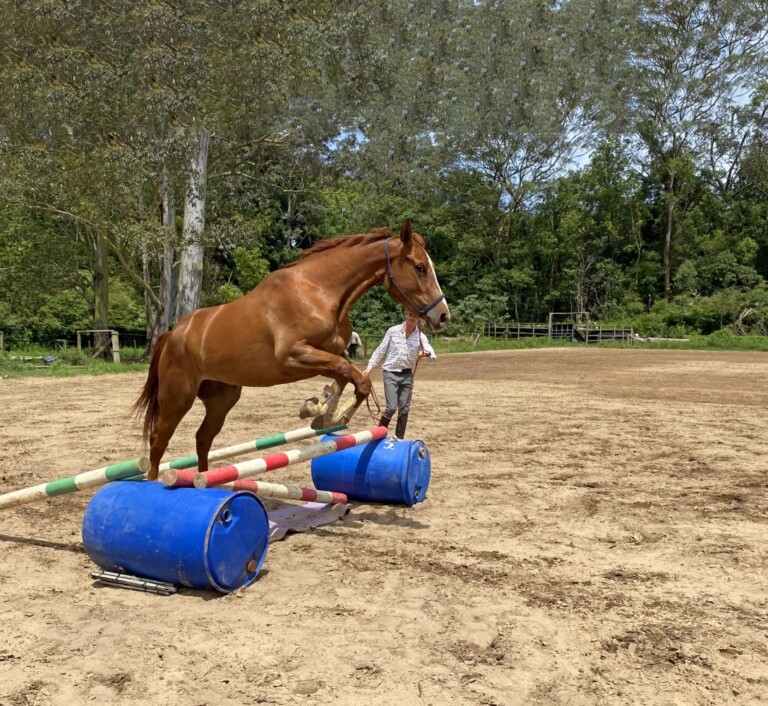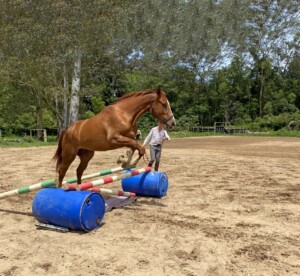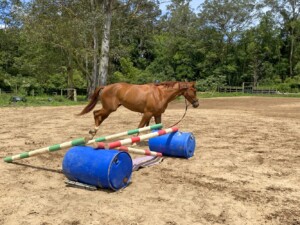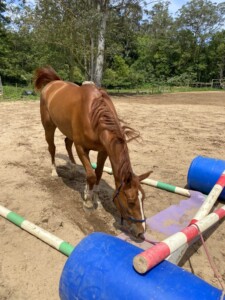In the final part of this series, resident columnist CHARLIE BRISTER adds jumping into the lunging mix.
If you aren’t dizzy from practicing your circle work after the last article, let’s jump into the next instalment. Moving away from simple circles and transitions we look at incorporating jumping into your lunge work.
Recap from Parts 1 and 2
Before we go any further, here’s a quick recap of the groundwork we’ve covered so far:
- Keeping your horse’s focus on you and not on what’s going on outside the circle.
- Lunging a rider with or without stirrups to improve their seat.
- Ensuring the voice or postural cue comes before the physical aid.
- Working on transitions to develop strength and responsiveness.
- Focusing on tempo and line.
- Why lunging for long periods of time should be avoided.
Why to progress from poles to jumps
It’s always good to mix things up in your training regime. Too much of any one thing can lead to both horse and rider getting a little bored. It’s just the same with lunging. Lunge in different places, try different transitions. Not everything needs to be mixed up though! Make sure your aids and communication with your horse remain as consistent as possible, regardless of the day or your own mood.
Now let’s talk about why you should get your horse to progress from pole work to jumping on the lunge. Regardless of your discipline this is a beneficial exercise. Even if you ride only for pleasure, you can help your horse improve their jumping with these hoof-eye coordinating exercises. William Micklem who designed the Micklem bridle calls it fifth leg training.
With a pole on the ground the horse doesn’t have to change the way they use their body to get over the obstacle. When you start to raise the pole so that it becomes more of a jump, the horse has to rock onto their hind end and push off the back legs with more power than normal. By doing this without a rider on their back the horse doesn’t have to worry about anything except their own legs and the jump. When they become stronger and more confident they ll be able to handle a rider whose weight is going to affect the horse when jumping.
Without the rider the horse can focus easily on the job at hand and quite often this can accelerate the learning process. I certainly find jumping easier without someone sitting on my shoulders!
Setting up for success
How can you make it as easy as possible for the horse? Start small and be progressive. Check all the stop and go buttons on your horse first. Your plan might be to jump them but if they wake up on the wrong side of the stable and are not focussing, go back to the basics. You need to have their attention on you and have control of their tempo and line.
Once you are happy with that let’s set the jump up. While free jumping a horse down a lane is great, it requires a lot more gear and you have less control over a horse’s speed. Similar to a free-jumping lane we want to help channel the horse towards the jump. This can be done very easily with two guide rails to aid with straightness. You can set up two rails on the ground between two 44 gallon drums. Start with them on the ground before building that up to a cross rail.
Starting and problem solving
If you are starting in a round yard things will be considerably easier. The wall prevents the horse from running to the outside. Starting small with a guide rail on the inside will hopefully be enough.
Begin in trot and allow the horse to canter if they make that decision just in front of the jump. If the horse jumps and loses energy ask for an upward transition shortly after the jump. Alternatively if the horse rushes before or after the fence gently ask for a downward transition before jumping again.
Sometimes the horse tries to run past the side of the jump. Slow everything down and make sure the jump isn’t too big. Re-check all the basics and give your horse plenty of time to look at and sniff the fence so they become more confident near it. When a horse stops at the jump it either means they have been over-faced (presented with a jump that’s too big for their level of training) or you gave them a less than ideal preparation before the jump. Remember, the horse isn’t trying to be naughty if he stops or runs out, they are just reacting to the environment and the information we’re giving them.
Once the horse is trotting over a small fence from both directions you can have them canter over it on both reins too. Don’t forget to check your stop button after the fence. This will be very useful when you start them jumping out in the open. Jumping can adrenalise a horse and they might get a bit excited after the fence. No one wants to impersonate a water skier across the arena! When jumping in a round yard, keep the jumps under one metre to minimise the stress on the legs that occurs when they jump on a turn.
Watch them as they jump. Do they drift one way or another? Do they prefer a slower speed or being more forward? Are they more comfortable on the left or the right rein? This is all valuable information that can help both with your ground training and when you mount up.
Progression of the exercise
This can be a good time to introduce tarps or fill under the jump. Fill is anything besides a pole that adds to the visual impact of the jump. This can be a yoga mat, chaff bag, brick wall or painted wood panels. When introducing something new make sure you give them plenty of time to look at it before you expect them to jump it. Getting them confident is always a priority.
Most horses will benefit from doing this before being jumped under saddle. Even if your horse is quite experienced it can be really good for them to figure it out on their own again. After being able to jump your horse in both directions and have them stop easily you can take them out of the round yard to jump in the arena or a cross country paddock.
Showing the horse ditches and water jumps on the lead is very helpful for the horse’s confidence. If you have poles lying around your paddock, by all means use them I do if they’re available. But if not, it’s hard yakka taking poles around to set up as guide rails. You’re better off making sure your horse is jumping well on the lunge in the round yard before heading out into those wide open spaces – and when you do, just start small and let the horse tell you what they’re ready for.
This is a real test for how well your horse is listening to you so there is no need to rush into doing it if you are not sure. We can’t all be like Kelly Wilson jumping her horses at liberty in front of a packed arena.
What happens when it’s not happening?
If you do get stuck, there’s always another day. It is better to quit and come back better prepared rather than get frustrated and keep the horse going around and around while you try and make it do exactly what you want.






